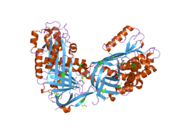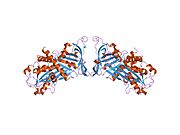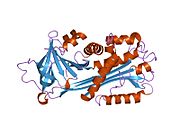Biology:Maspin
 Generic protein structure example |
Maspin (mammary serine protease inhibitor) is a protein that in humans is encoded by the SERPINB5 gene.[1] This protein belongs to the serpin (serine protease inhibitor) superfamily.[1] SERPINB5 was originally reported to function as a tumor suppressor gene in epithelial cells, suppressing the ability of cancer cells to invade and metastasize to other tissues.[2] Furthermore, and consistent with an important biological function, Maspin knockout mice were reported to be non-viable, dying in early embryogenesis.[3] However, a subsequent study using viral transduction as a method of gene transfer (rather than single cell cloning) was not able to reproduce the original findings and found no role for maspin in tumour biology.[4] Furthermore, the latter study demonstrated that maspin knockout mice are viable and display no obvious phenotype.[4] These data are consistent with the observation that maspin is not expressed in early embryogenesis.[4] The precise molecular function of maspin is thus currently unknown.
Tissue distribution
Maspin is expressed in the skin, prostate, testis, intestine, tongue, lung, and the thymus.[1]
Serpin superfamily
Maspin is a member of the serpin superfamily of serine protease inhibitors.[1] The primary function of most members of this family is to regulate the breakdown of proteins by inhibiting the catalytic activity of proteinases. Through this mechanism of action, serpins regulate a number of cellular processes including phagocytosis, coagulation, and fibrinolysis.[5]
Serpins have a complex structure, a key component of which is the reactive site loop, RSL.[6] Inhibitory serpins transition between a stress and relaxed stage. The catalytic serine residue in the protease target attacks the stressed conformation of the RSL loop to form an acyl intermediate. The loop then undergoes a conformational change to the relaxed state irreversibly trapping the protease in an inactive state. Hence the serpin functions as a suicide inhibitor of the protease.[7] This transition does not occur in serpins that lack inhibitory activity.[6]
Function
Given its original reported role in cancer biology,[2] numerous studies have investigated a role for maspin in tumour metastasis.[8] However, to date no detailed molecular mechanism for maspin function in cell proliferation or tumour biology has been comprehensively described. Further, it is suggested that original reports of maspin as a tumor suppressor may reflect clonal artefacts rather than true maspin function.[4] Importantly, and in contrast to original reports, maspin knockout mice are viable, displaying no overt phenotype in the absence of suitable biological or environmental challenge.[4] Accordingly, the molecular function of maspin remains unclear.
From a structural perspective, maspin is a non-inhibitory and obligate intracellular member of the serpin superfamily.[9] Specifically, its RSL does not transition between a stressed and relaxed state following proteolytic cleavage.[10] This region is also shorter than the RSL loop in other serpins. Accordingly, in the absence of an obvious protease-related function, other targets of maspin have been suggested. For example, rather than being a protease inhibitor, maspin is proposed to function as an inhibitor of histone deacetylase 1 (HDAC1).[6][11]
Clinical significance
A comprehensive analysis of maspin expression in breast cancer revealed no significant correlation between maspin expression and overall survival, distant metastasis-free survival or recurrence-free survival.[4] Changes in maspin expression may, however, reflect the expression status of the known tumour suppressor PHLPP1.[4]
References
- ↑ 1.0 1.1 1.2 1.3 Khalkhali-Ellis Z (December 2006). "Maspin: the new frontier". Clin. Cancer Res. 12 (24): 7279–83. doi:10.1158/1078-0432.CCR-06-1589. PMID 17189399.
- ↑ 2.0 2.1 "Maspin, a serpin with tumor-suppressing activity in human mammary epithelial cells". Science 263 (5146): 526–9. 1994. doi:10.1126/science.8290962. PMID 8290962. Bibcode: 1994Sci...263..526Z.
- ↑ "Maspin plays an essential role in early embryonic development". Development 131 (7): 1479–89. 2004. doi:10.1242/dev.01048. PMID 14985257.
- ↑ 4.0 4.1 4.2 4.3 4.4 4.5 4.6 "Maspin is not required for embryonic development or tumour suppression". Nat Commun 5: 3164. January 2014. doi:10.1038/ncomms4164. PMID 24445777. Bibcode: 2014NatCo...5.3164T.
- ↑ "The serpin superfamily of proteinase inhibitors: structure, function, and regulation". J. Biol. Chem. 269 (23): 15957–60. June 1994. doi:10.1016/S0021-9258(17)33954-6. PMID 8206889.
- ↑ 6.0 6.1 6.2 "Maspin: A Tumor Suppressing Serpin". Attempts to Understand Metastasis Formation I. Current Topics in Microbiology 213/I and Immunology. 213. 1996. 51–64. doi:10.1007/978-3-642-61107-0_4. ISBN 978-3-642-64697-3.
- ↑ "Biological functions of maspin". J. Cell. Physiol. 209 (3): 617–24. December 2006. doi:10.1002/jcp.20782. PMID 17001697.
- ↑ "Nuclear cytokine-activated IKKalpha controls prostate cancer metastasis by repressing Maspin.". Nature 446 (7136): 690–4. 2007. doi:10.1038/nature05656. PMID 17377533. Bibcode: 2007Natur.446..690L.
- ↑ "Maspin (SERPINB5) is an obligate intracellular serpin.". J Biol Chem 285 (14): 10862–9. 2010. doi:10.1074/jbc.M109.073171. PMID 20123984.
- ↑ "The tumor suppressor maspin does not undergo the stressed to relaxed transition or inhibit trypsin-like serine proteases. Evidence that maspin is not a protease inhibitory serpin.". J Biol Chem 270 (26): 15832–7. 1995. doi:10.1074/jbc.270.26.15832. PMID 7797587.
- ↑ "The natural tumor suppressor protein maspin and potential application in non small cell lung cancer". Curr. Pharm. Des. 16 (16): 1877–81. June 2010. doi:10.2174/138161210791208974. PMID 20337574.
Further reading
- Maspin. A tumor suppressing serpin.. Adv. Exp. Med. Biol.. 425. 1998. pp. 77–88. doi:10.1007/978-1-4615-5391-5_8.
- Sheng S (2006). "The promise and challenge toward the clinical application of maspin in cancer.". Front. Biosci. 9 (1–3): 2733–45. doi:10.2741/1432. PMID 15353310.
- "Tumor suppressive maspin and epithelial homeostasis.". J. Cell. Biochem. 97 (4): 651–60. 2006. doi:10.1002/jcb.20721. PMID 16329135.
- "Maspin and tumor metastasis.". IUBMB Life 58 (1): 25–9. 2006. doi:10.1080/15216540500531721. PMID 16540429.
- Khalkhali-Ellis Z (2007). "Maspin: the new frontier.". Clin. Cancer Res. 12 (24): 7279–83. doi:10.1158/1078-0432.CCR-06-1589. PMID 17189399.
- "A serine proteinase inhibitor locus at 18q21.3 contains a tandem duplication of the human squamous cell carcinoma antigen gene.". Proc. Natl. Acad. Sci. U.S.A. 92 (8): 3147–51. 1995. doi:10.1073/pnas.92.8.3147. PMID 7724531. Bibcode: 1995PNAS...92.3147S.
- "The tumor suppressor maspin does not undergo the stressed to relaxed transition or inhibit trypsin-like serine proteases. Evidence that maspin is not a protease inhibitory serpin.". J. Biol. Chem. 270 (26): 15832–7. 1995. doi:10.1074/jbc.270.26.15832. PMID 7797587.
- "Maspin, a serpin with tumor-suppressing activity in human mammary epithelial cells.". Science 263 (5146): 526–9. 1994. doi:10.1126/science.8290962. PMID 8290962. Bibcode: 1994Sci...263..526Z.
- "Maspin is an intracellular serpin that partitions into secretory vesicles and is present at the cell surface.". J. Histochem. Cytochem. 45 (12): 1697–706. 1998. doi:10.1177/002215549704501213. PMID 9389773.
- "High tumoral maspin expression is associated with improved survival of patients with oral squamous cell carcinoma.". Oncogene 19 (20): 2398–403. 2000. doi:10.1038/sj.onc.1203535. PMID 10828881.
- "Pleiotrophic inhibition of pericellular urokinase-type plasminogen activator system by endogenous tumor suppressive maspin.". Cancer Res. 61 (24): 8676–82. 2002. PMID 11751384.
- "Evidence for a direct interaction between the tumor suppressor serpin, maspin, and types I and III collagen.". J. Biol. Chem. 277 (13): 10783–8. 2002. doi:10.1074/jbc.M110992200. PMID 11788595.
- "The tumour suppressor gene maspin is differentially regulated in cytotrophoblasts during human placental development.". Placenta 23 (4): 274–80. 2002. doi:10.1053/plac.2001.0784. PMID 11969337.
- "Maspin sensitizes breast carcinoma cells to induced apoptosis.". Oncogene 21 (26): 4089–98. 2002. doi:10.1038/sj.onc.1205507. PMID 12037665.
- "Tyrosine phosphorylation of maspin in normal mammary epithelia and breast cancer cells.". Biochem. Biophys. Res. Commun. 295 (4): 800–5. 2002. doi:10.1016/S0006-291X(02)00764-7. PMID 12127964.
- "Hypermethylation and histone deacetylation lead to silencing of the maspin gene in human breast cancer.". Biochem. Biophys. Res. Commun. 297 (1): 125–8. 2002. doi:10.1016/S0006-291X(02)02136-8. PMID 12220518.
- "The paradoxical expression of maspin in ovarian carcinoma.". Clin. Cancer Res. 8 (9): 2924–32. 2002. PMID 12231537.
- "Maspin expression in human gastric adenocarcinoma.". Pathol. Int. 52 (8): 508–13. 2003. doi:10.1046/j.1440-1827.2002.01381.x. PMID 12366809.
- "Maspin inhibits cell migration in the absence of protease inhibitory activity.". J. Biol. Chem. 277 (49): 46845–8. 2003. doi:10.1074/jbc.C200532200. PMID 12384513.
External links
- The MEROPS online database for peptidases and their inhibitors: I04.980
- maspin at the US National Library of Medicine Medical Subject Headings (MeSH)
 |





